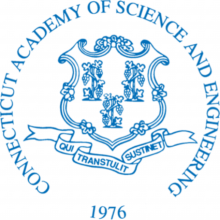HARTFORD, CT – Thomas A. Steitz was a co-winner of the 2009 Nobel Prize in Chemistry for his work describing the structure and function of the ribosome, the protein making factory key to the function of all life. Steitz is the keynote speaker at tonight’s 35th Annual Meeting of the Connecticut Academy of Science and Engineering – taking place at 7:00 p.m. at the Hartford Marriott Downtown Hotel, preceded by a reception at the Connecticut Science Center. Steitz is the Sterling Professor of Molecular Biophysics and Biochemistry and Professor of Chemistry at Yale University, where he has been on the faculty since 1970. He has been a Howard Hughes Medical Institute investigator since 1986.
Steitz’ research has focused on the molecular mechanisms by which the proteins and nucleic acids involved in the central dogma of molecular biology carry out gene expression from replication and recombination of the DNA genome, to its transcription into mRNA, followed by the various components associated with the translation of mRNA into protein. Not only are these processes fundamental to all life forms, but many of the macromolecules involved in these processes are known or potential targets for therapeutic drugs. Steitz and his two Nobel co-winners used a technology called X-ray crystallography to map the position for each and every one of the hundreds of thousands of atoms that make up the ribosome. His collaboration with Yale colleague and fellow CASE member Peter Moore and interactions with William Jorgenson, also of Yale’s chemistry department, led to the establishment of a company, Rib-X Pharmaceuticals, Inc., which is using this knowledge to create new classes of antibiotics.
A graduate of Lawrence College in Appleton, Wisconsin, Steitz earned his PhD in molecular biology and biochemistry from Harvard. His other awards include the Pfizer prize from the American Chemical Society, the Rosenstiel Award for distinguished work in basic biomedical sciences, the AAAS Newcomb Cleveland Prize, the Keio Medical Science Prize, and the Gairdner International Award.
Steitz has been a member of the Connecticut Academy of Science & Engineering since 1991. He is also a member of the National Academy of Sciences, the American Academy of Arts & Sciences, the American Crystallographic Association, the Biophysical Society and the American Society of Biochemistry and Molecular Biology.
###

